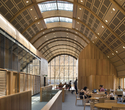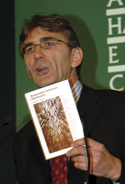Building for a new environment
14 November 2009Recession was discussed at American Hardwood Export Council European Convention, but the main topic was timber’s prospects in the global drive to sustainable construction
Summary
• Recession depressed US hardwood output and exports this year.
• Environmental issues are driving developments in construction.
• AHEC has launched a new website and species guide.
• A US hardwood life cycle analysis project launches in 2010.
Green building was a natural theme for The American Hardwood Export Council European Convention in Athens last month.
Environmental performance has taken centre stage in construction worldwide and, the 150-strong audience of US hardwood suppliers and their European customers were told, the implications are critical for timber generally and US hardwood in particular.
According to speakers from across the trade, research bodies and leading customer sectors, the industry can exploit this seismic shift in its most important market by promoting wood’s blend of performance and environmental strengths – and much of AHEC’s own activity is geared to doing just that. But the new green building culture poses challenges too, notably more aggressive eco marketing from rival material industries and a widespread perception in government and specifier circles that certification is the only acceptable proof of timber sustainability.
Recession survival
The convention did also acknowledge that the sector has had one other fairly major concern over the last 18 months – namely recession. “Our main focus recently has been little else but survival,” acknowledged one European trader.
Ed Pepke of the UNECE Timber Committee put the seriousness of the situation into equally stark perspective. The 6% global slide in GDP, he said, made it the “worst downturn since the second world war”. “And without government intervention, we’d be in another great depression.”
The UNECE’s Forest Products Annual Market Review underlined the impact of the crash on global timber trade overall and forecast 2009 US hardwood output down 5% at 22 million m³ and Europe’s production 7% lower at 13 million m³. Other reports put US hardwood exports to August 31% lower at US$566m, with sales to the EU down 36% at US$144m.
Next year should see more positive global GDP figures, leading to a UNECE forecast rise of 4.5% in total US hardwood exports and a 6% increase in EU imports. But a convention panel drawn from the US and Europe to discuss the issue, cautioned that there were still market blockages hampering return to more rapid growth. One, said Matt Gauvrit of American Hardwood Industries, was unsold housing stock worldwide. “We won’t see robust recovery until the property market starts to move this inventory,” he said.
Business credit
According to Orne Gudmundsson Jr of Northland Corporation and AHEC chairman, the lack of business credit was another obstacle. “Financial institutions are awash with cash," he said, "but it’s still not feeding through to the market.”
However, while recession may have focused timber companies temporarily on the short term, the consensus was that the long-term shift to more sustainable building and tighter eco regulation has continued and responding to this will be more urgent as economies pick up. In fact,speakers agreed, the industry’s success here could determine whether green building was a driver for timber out of the slump, or impeded its recovery.
According to Rupert Oliver of Forest Industries Intelligence the pressures on the building sector to improve its carbon footprint are now set to grow even faster. “Construction and the built environment account for 50% of CO2 emissions worldwide, and there will be growing demands to tackle that,” he said.
Against this background, timber’s inherent renewability was a real advantage. “But there’s a danger it could tempt the industry into passivity, while other [materials] sectors invest increasingly in stressing their greenness.”
AHEC executive director Mike Snow agreed that the onus was on the timber industry to become more assertive on the environment. “Too often we’ve played defence instead of taking the initiative,” he said.
A particular problem that needed to be tackled, he added, was governments and the construction industry opting for third-party timber certification as their environmental specification default. This was especially critical for the US which, while it accounts for 25% of internationally traded hardwood, still only ships 3-4% of its export total as certified.
“That’s due to fragmented US forest ownership,” said Mr Snow. “We have nine million private owners and, since they hold an average 20ha and harvest maybe once a generation, most just don’t see the sense of certification.”
At the same time, he stressed, the American hardwood forest is patently sustainable. It is growing year on year and the 2007 AHEC study commissioned from consultants Seneca Creek showed it was very low risk in terms of illegal wood getting into the supply chain.
To avoid being railroaded into a certification-only approach, said Mr Snow, the industry should highlight that it is not a universal solution and promote wider acceptance of risk assessment-based legislation to tackle illegal timber trading, like America’s Lacey Act and proposed new EU regulations. “Right now just 8% of forest worldwide is certified and over 90% of that is in temperate developed countries, so it’s mostly reinforcing existing good forest management,” he said. “We should make life harder for illegal loggers in endangered areas, not overburden low risk areas with expensive controls when they’re already doing a good job.”
Environmental rating systems
Another challenge for timber in the green building revolution was to make the Case for reform and change in the burgeoning construction environmental rating systems, such as America’s LEED and the UK’s BREEAM schemes. “Currently these give no credit to materials for embodied carbon or energy required in production,” said Mr Snow. “Yet some give points for using certified timber, so we’re being held to a different standard from steel, plastic and concrete.”
The green building and procurement thread also found its way into the presentation by AHEC Europe director David Venables on its work to “create new opportunities for US hardwoods in Europe”. A central focus of this is to make specifiers more aware of the sheer variety of American hardwoods and their different characteristics, with latest initiatives including the launch of a revamped species guide and a new specifier- and designer-friendly website, www.americanhardwood.org.
“We’re also highlighting best applications of US hardwoods in our media campaign and forging relations with the design community to collaborate on getting our story out there,” he said. “For instance, leading UK architect Alison Brooks recently addressed our architectural seminar in Munich. She’s a terrific advocate of timber and, coming from her, the message had huge impact.”
But AHEC’s promotional effort is also aimed at putting American hardwoods “at the centre of the green building debate”. As a result, data on sustainability figures highly in the new species guide and website. “And we also see it as vital to back our environmental case with science,” said Mr Venables.
Life cycle analysis
To this end in 2010, he added, AHEC is funding the “most comprehensive” ever project for US hardwoods in the core green building science of life cycle analysis. It is also continuing its collaboration with Osmose to perfect treatment of tulipwood for exterior use. The latterproject is primarily about improving technical performance, but also has a green hook in that tulipwood is among the most prolific US species, so broadening its market makes better use of the resource.
Meanwhile, speaker Jim Greaves of UK-based Hopkins Architects highlighted the potential rewards of convincing the construction community of the performance and eco attractions of timber, but also the challenges ahead. Hopkins has amassed an impressive range of buildings using wood structurally and internally, including such prestige projects as the Wood Awards-winning Norwich Cathedral visitors’ centre in the UK and the LEED ‘platinum’-rated Forestry and Environmental Studies centre at Yale University in the US. In the future the practice wants to use timber even more extensively, but Mr Greaves agreed with other speakers that the growing complexities of certification, eco-rating schemes and government procurement rules threaten to make it more difficult, and that’s something the industry must tackle. “We just want to design more nice buildings in wood,” he said, “but there are increasing hurdles being thrown in our way.”


